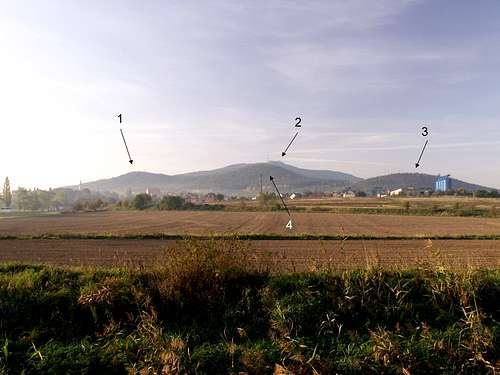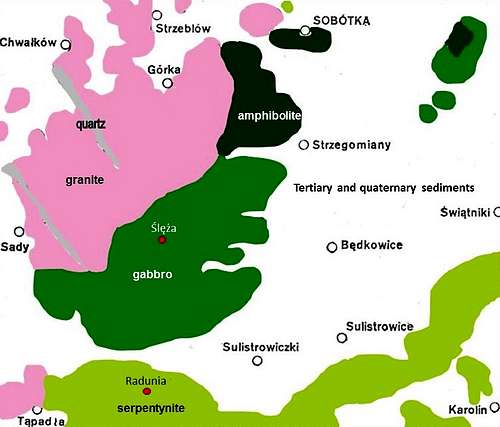-
 1244 Hits
1244 Hits
-
 73.06% Score
73.06% Score
-
 3 Votes
3 Votes
|
|
Album |
|---|---|
|
|
Informational |
Mountains? – to see more, to know more, to give more…

GEOLOGICAL OVERVIEW
Three types of rocks are distinguished in the Ślęża Massif: granite in various varieties in the north-western area of the massif, gabbro in the south-eastern part and amphibolites in the north-eastern part. Some of these rocks have been metamorphosed, hence they are referred to as metagranite, metagabbro, etc. In the crystalline bedrock, the range of rocks is much greater than that observed in a given mountain. Then the rocks of the massif may appear in the form of outcrops beyond it. This approach is used in this album and also concerns geological objects outside the massif, such as: a closed serpentinite and nephrite quarry near Jordanów, a small metabasalt quarry on the Kunowska Mt., a closed magnesite mine near the village of Wiry, granite quarries lying N-W of the massif and the serpentinite range lying in direct contact with the Ślęża Massif, from the south. This range is formed toward the W-E direction by the Kiełczyn Hills, the Radunia Massif and the Oleszna Hills. Each of the presented rocks is composed of its own characteristic minerals and their secondary derivatives, with examples below.
A closed magnesite mine near the village of Wiry - the magnesite deposit was formed in the weathered serpentinite rocks. Apart from serpentinite, the following rocks coexist there: gabbro, granite pegmatite, amphibolite and two-mica granite. Many minerals have been identified there: magnesite, chrysoprase, opal, chrysotile, beryllium, chromite, diallage, garnet, chalcedony, quartz, dolomite, calcite, talc, thulite and Ni-clay minerals - kerolite, sepiolite, saponite. A few years ago, geological specimens could be obtained from large heaps of the mine spoil. It is currently impossible, as the material from the heaps has been used as ballast in road construction.
A working serpentinite quarry near the village of Nasławice - in the variegated serpentinites there are serpentine group minerals: chrysotile, lizardite, antigorite. Chrysotile comes in the form of plates and fibrous asbestos. Other minerals are magnetite, talc, dolomite and opal. In the layers of serpentinite, in the form of lenses, there was formed a multicoloured metamorphic, calcareous-silicate rock - rodingite. Zoisite, epidote, vesuvianite and grossular are minerals which were detected in rodingite from the Nasławice quarry. Rodingite was also found in the serpentinite quarry located to the south of Świątniki.
An old, closed serpentinite and nephrite quarry is situated to the north-west of Jordanów Śląski. The deposit is made of the same minerals as in the Nasławice quarry, and some moreover: quartz, albite, tremolite, diopside, prehnite, grossular, vesuvianite and aragonite. Stone tools made of local nephrite testify that the quarry was already in use in the Neolithic period. Small old serpentinite pits were also discovered on Jańska Mt. located to the east of Radunia Mt.
In the old, closed quarry on Kunowska Mt., located to the east of Sobótka, there were identified metabasalt and metagabbro rocks. Ilmenite was found in metabasalts and amphibolites between this mountain and the village of Strzegomiany (E slope of the Ślęża Massif).
Around the Strzeblów village, westwards from Sobótka, there are many granite quarries, at present not exploited. One can also find there some type of a white granite (leucogranite) composed of 70-75% of quartz and orthoclase. It has sometimes small brown inclusions of iron oxides. The NW part of Ślęża Mt. is composed of granite changed into diorite with large amount of biotite. The production of querns made from a local granite started here during the VI-Vc. BC. These querns were exported very far, one specimen was found in the Viking settlement in Haithabu, Germany. Up to XIII c. AD ca 10,000 granite querns were made. Large sculptures, the most interesting monuments of the Ślęża Massif, were also made from the local granite. They are known as a girl with fish, several ones in the form of a bear, a pilgrim, a monk and a boar. The sculptures origin probably from the period, since 400 BC to the beginning AD. The contact surface of granite rocks with other ones is composed of different type of granite, rich in two micas, biotite and muscovite. This type of a rock has sometimes small red inclusions of garnet creating red gems. In the western granite part of the massif two large veins of pure quartz were discovered. Quartz was mined in two quarries, 'Białe Krowy' (White Cows) and on Kwarcowa Mt., on the western slope of the massif. This quartz contains small amounts of amethyst.
The NE part, where Wieżyca Mt. (415 m a.s.l.) is covered by rich beech and thermophilous oak forests, consists of a metamorphic dark green rock called amphibolite. Its grey-green naked boulders cover the summit of Wieżyca Mt. The southern part of massif with the main summit of Ślęża and Olbrzymki Mt. is covered by outcrops of hard gabbro. It is a coarse grained magma rock. A large area occupied by the massif of Radunia, Oleszna and Kiełczyn Hills is built from a dark or light green rock, serpentinite. This part is the largest serpentinite mountains in Poland. Outcrops of serpentinite we can also see in the old quarries near villages: Tąpadła, Wiry, Kiełczyn, Słupice, Świątniki and Przemiłów. Small amounts of black or brown chromite with admixture of platinum were exploited on the NW slope of Czernica Mt. (481 m a.s.l.) in the Radunia massif. A metamorphic green rock called nephrite is rare and creates small inclusions in serpentinite. The only bed of nephrite in Poland is here, near Jordanów Śląski, small village situated several kilometers eastwards from Sobótka. This bed is small but world known. Another mineral, magnesite, was exploited in the past quarries in Sobótka, near Strzeblów and in the village of Wiry mentioned above. A beautiful green and blue mineral chrysoprase, the best variety of chalcedony, was discovered together with magnesite in the Wiry quarry. This overview (see also information attached to each picture) on minerals and rocks of the Ślęża Massif is only a short story of geological wealth of Lower Silesia. Mountains of this province are geologically most interesting in Poland.
A pin or a match has been used in some pictures for size comparison.
It will be continued …



